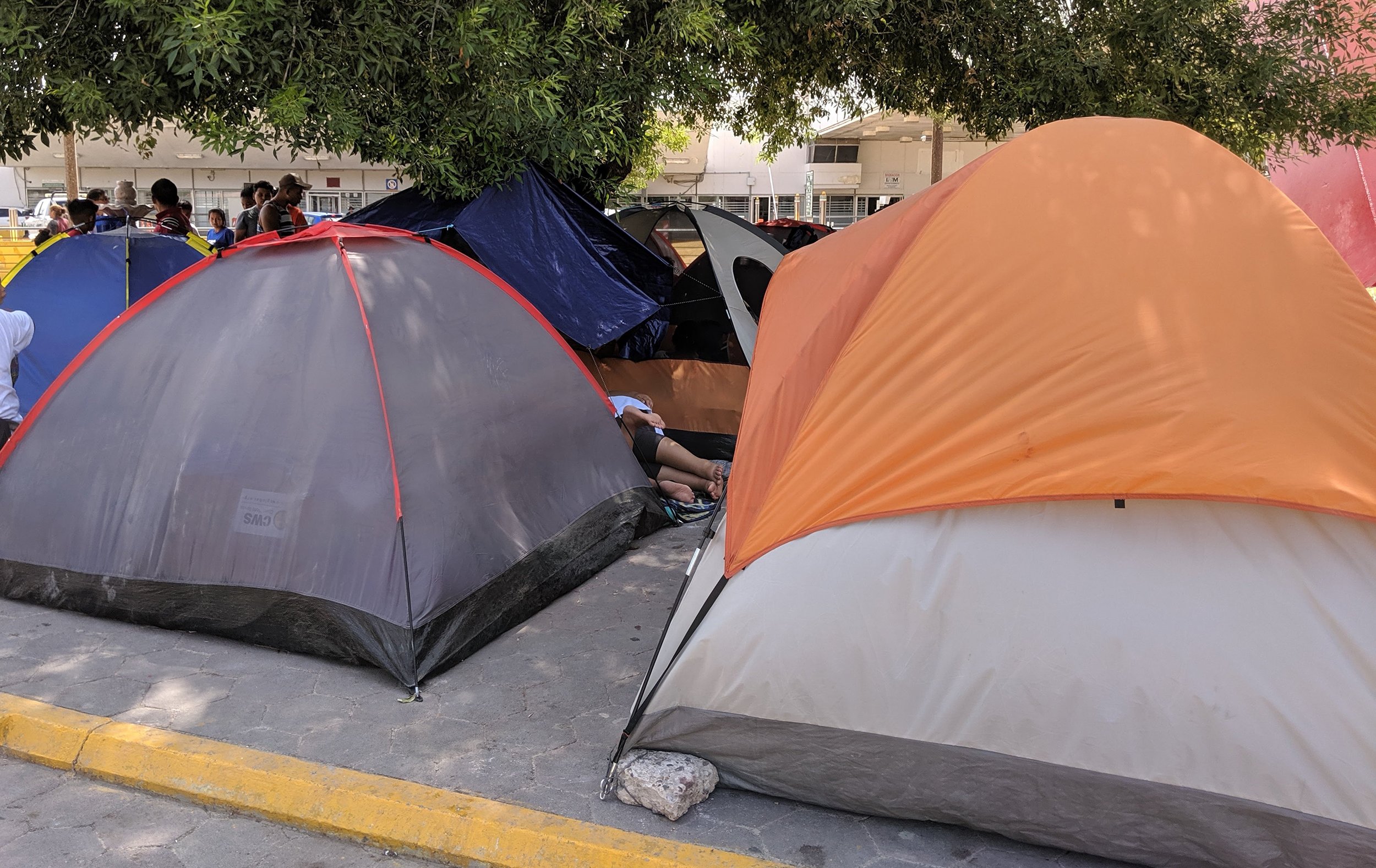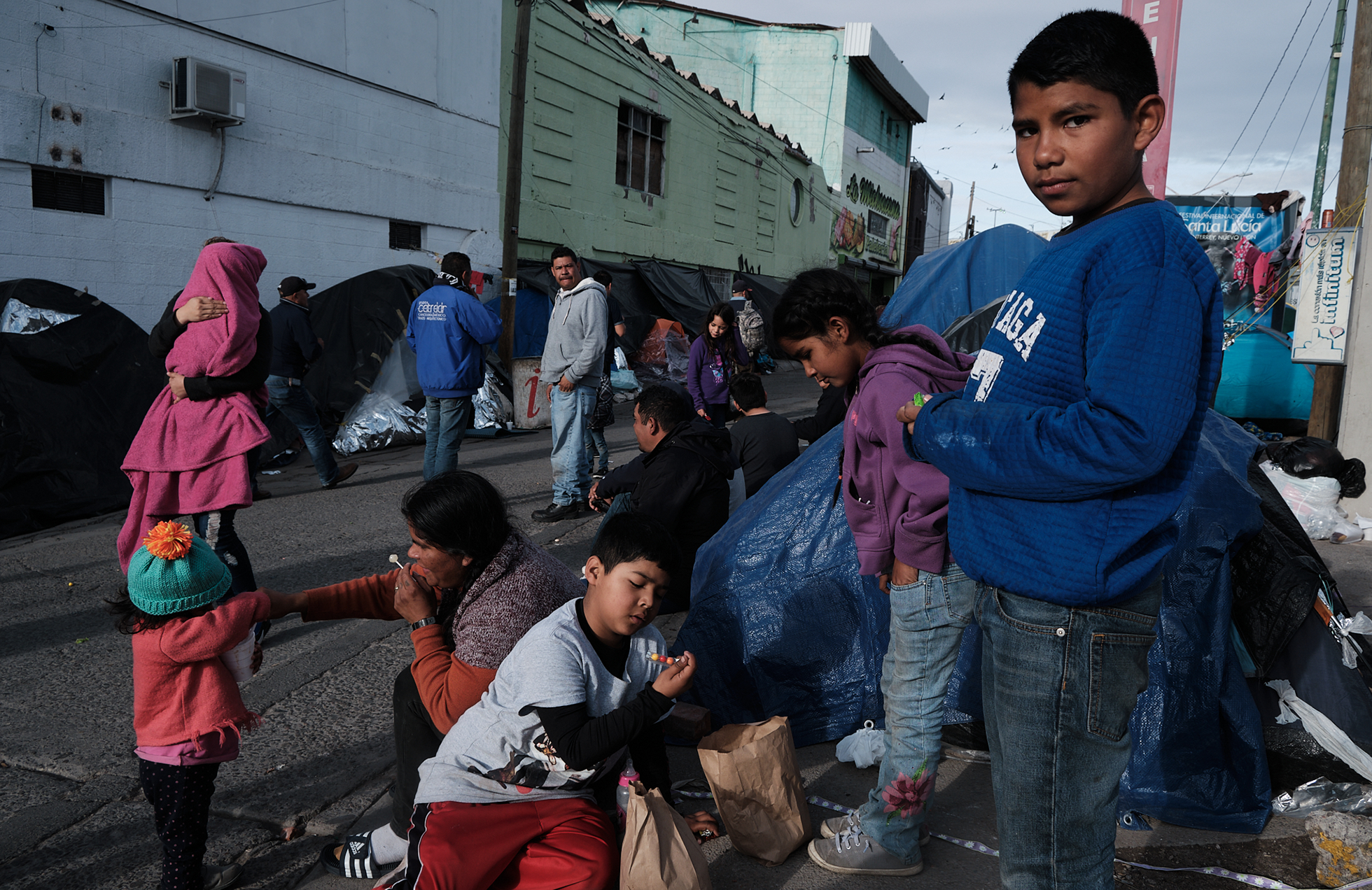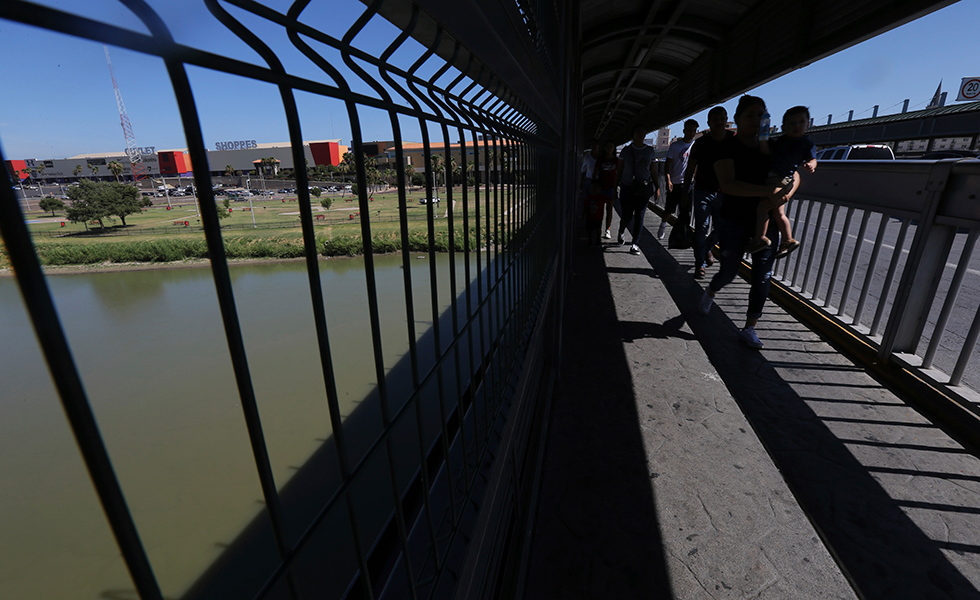
Confusion Reigns in Matamoros Migrant Camp Over ‘Remain in Mexico’
Amid a chaotic back-and-forth caused by a court ruling, asylum-seekers in Matamoros are still waiting.
On a cloudy day in Brownsville, the pops of color just across the Rio Grande are barely visible among dense greenery. But as I cross the bridge to Matamoros, the fog begins to clear. Along the riverbank, I see a rainbow of tarps behind a chain-link fence, the makeshift settlement stretching into this cartel-dominated city of 500,000. Here, thousands of people wait for the chance to apply for asylum.
Last week, there was hope that the wait might be over for those in the Brownsville-Matamoros camp. On Friday, the U.S. 9th Circuit Court of Appeals in San Francisco upheld an injunction on the Migrant Protection Protocols (MPP), colloquially known as Remain in Mexico. The court argued that by making asylum-seekers wait in Mexico, the United States is breaking federal immigration law and violating international treaties for the protection of refugees. The ruling set off a chaotic back-and-forth: A few hours after its decision, the court granted the Trump administration an emergency stay, which has been extended until March 11. The court then said that if the Supreme Court does not respond by that date, MPP will be blocked in California and Arizona—which are under its jurisdiction—but not in New Mexico and Texas. So, as of now, MPP remains in place across the U.S.-Mexico border.
Meanwhile, confusion abounds in the camp. Andrea Rudnik, co-founder of Team Brownsville, a volunteer group that works with asylum-seekers, was at the Matamoros camp when news spread that MPP was blocked. She says people immediately lined up at the Gateway International Bridge, hoping they would be allowed to cross. As they began to queue, she says, the number of U.S. Customs and Border Protection (CBP) agents on the bridge quadrupled, all wearing heavy tactical gear.
“Maybe less than 1 percent of those in the camp will make it across to the U.S. This is creating a spirit of hopelessness.”
“There was excitement in the air, but an attorney was asking for help getting people to calm down, because they didn’t know what the outcome would be,” Rudnik says.
As migrants packed their belongings, Rudnik says, they received word that MPP was no longer blocked. Then came the tears. “Some people refused to leave [the bridge], distraught it had failed again,” Rudnik says.
Robert E. Perez, deputy commissioner for CBP, said in a Friday court filing that approximately 60,000 migrants have been returned to Mexico under MPP, while about 25,000 are waiting in Mexico. The government, he believes, needs more time to put a plan in place. “It would take a significant number of hours to process individuals into the United States,” Perez said in the filing.
But for the nearly 3,000 asylum-seekers in the Matamoros camp, time is precious.
Onelia Alonso arrived in Matamoros a month ago. The human rights activist fled her native Cuba after being held and tortured as a political prisoner, landing in Trinidad and Tobago as a United Nations refugee in 2017. After not receiving refuge, she began a nine-month journey to the U.S. border, traveling by boat to Venezuela and Colombia and crossing the infamous Darién Gap on foot into Panama. When she arrived in Mexico, she and her brothers were kidnapped by a Mexican cartel but managed to escape. Today, she still receives threatening text messages from the cartel. U.S. asylum, she says, is her last hope of escaping a perilous situation.
“We are all waiting to see if we can cross because we are in a very unsafe place,” Alonso says. “The things that happen here, we live in constant danger of losing our life.”
Alonso says she told U.S. authorities she was a U.N. refugee, but her documents were dismissed and she was returned to wait in Mexico. Her next court date is set for March 12, when she hopes to prove her U.N. refugee status that expires just eight days later.
Abraham Barberi, a local pastor and volunteer at the camp, was on his way to visit family in Temple on Friday when he stopped for gas. Excited messages from migrants in the camp about the initial court ruling flooded his phone. “I am leaving brother, in case I don’t see you again,” one read. By the time he saw the texts, however, MPP had already been allowed to continue.
Now, Barberi and other volunteers are trying to keep migrants’ hopes in check.
“Maybe less than 1 percent of those in the camp will make it across to the U.S.” Barberi says. “This is creating a spirit of hopelessness.”

The Quintana family, who arrived from Guanajato, Mexico, two weeks ago and declined to give their first names for fear of persecution, took a bus to Matamoros after a drive-by shooting at their home. Under MPP, Mexican nationals seeking asylum in the U.S. can be sent to wait in Guatemala. They have yet to present themselves at the bridge for asylum. Mr. Quintana said that upon arriving, they heard rumors that entry is closed to Mexican nationals and that a worse future awaits Mexican nationals. He said they have been too afraid to ask for help or clarification from officials.
“We just want to start a new life,” Mrs. Quintana said.
As the camp continues to grow, Barberi says, resources are improving, but the migrants still rely entirely on volunteers for food, water, medical aid, and basic supplies. Over the past few months, aid organizations like Team Brownsville and Angry Tias and Abuelas of the RGV have joined forces with activists to coordinate an aid response effort and communicate with Mexican authorities.
Conditions have certainly improved since I visited the camp in October. Today, it has more toilets and showers, water tanks, a large tent that covers a makeshift dining room, and supply tents. Volunteers from medical teams are on-site, and 18,000 liters of water are delivered every day. Volunteers from the United Nations Refugee Agency deliver supplies, while UNICEF has set up small white tents for the children
But the physical and emotional toll of living in the camp for an extended period of time continues to affect the migrants. Santo Castro, who is from Honduras, has lived in the camp for over a year with his 9-year-old daughter. They were separated last year from his wife and other daughter, who are now in the United States. With tears in his eyes, he says Tuesday was his third wedding anniversary. For months, he has debated sending his daughter to the border alone in hopes she will be allowed to reunite with his wife in the United States, a practice that Barberi and other volunteers are trying to discourage.
To fill his time, Castro works at the Resource Center Matamoros, where he says he finds solace in helping others who are faring worse than him. At the center, Castro helps other migrants set up legal consultations and schedule notary services. He’s learning English so he can interpret forms. Since the organization received two donated cars, Castro and other center volunteers have been using one to drive migrants through the perilous streets of Nuevo Laredo to present themselves at the Laredo port of entry for court appearances. The other is used as a makeshift ambulance that runs around the clock.
Castro says when he heard about the MPP rulings, he helped gather migrants for information sessions with lawyers. He himself has little hope the policy will be blocked, but if it is, he fears it will be replaced with something worse.
“If they take away this law, I just hope it is for the better,” Castro says.
Read more from the Observer:
-
Off the Texas Gulf Coast, Tugboat Crews Are Stuck on Their Boats Without Pay: Bouchard Transportation, a massive shipping firm, hasn’t paid docking fees or worker salaries, leading to a rare quandary in U.S. waters.
-
Baffled City: Exploring the architecture of gentrification.
-
In ‘Barn 8,’ an Unsparing Look at the Industrial Chicken Industry: Deb Olin Unferth’s darkly comic novel imagines a chicken heist gone wrong—and takes on the factory farming industry.


